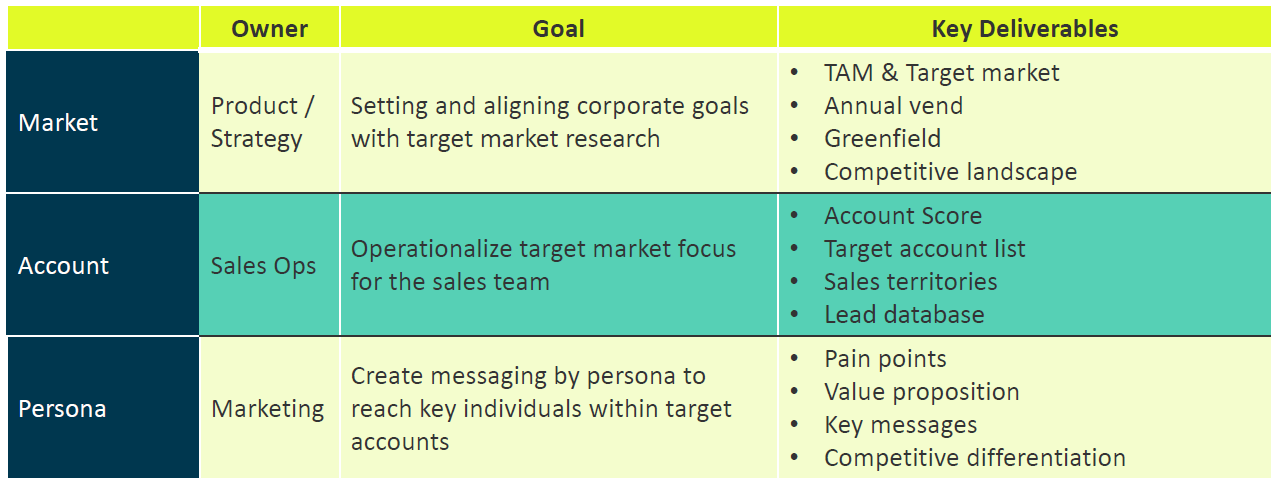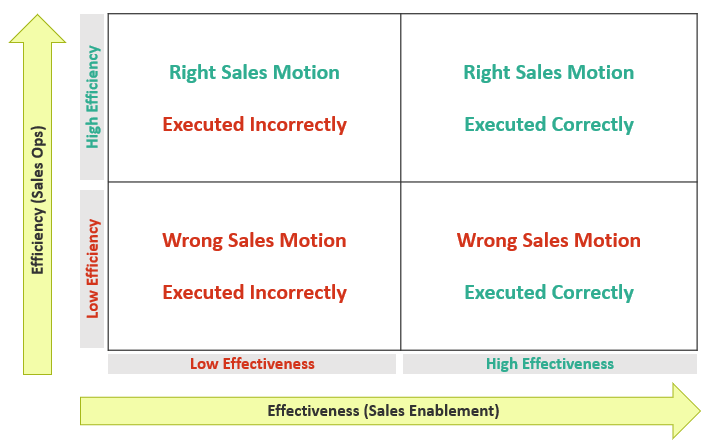Why Sales Operations May Be the Most Important Hire You Haven’t Made
At Mainsail, we believe that Sales Operations can help make the difference between good and great go-to-market (GTM) organizations. Has your business ever suffered from qualified leads falling through the cracks, missed forecasts, or a lack of visibility into the performance of the sales team altogether? These are all common challenges that sales ops can help address. In fact, the results of our 2018 Bootstrapped Survey showed that sales organizations who adopted many of the best practices owned or influenced by sales ops were more likely to view sales as a strength of their business.
This is why when we invest in a new company, sales ops is one of the first individual contributors we recommend our teams hire. In our experience, this function is uniquely capable of building consensus among revenue-generating departments to drive value for the business. The result is visibility, predictability, efficiency and clarity around decision-making.
Earlier this summer, Mainsail Partners’ Matt Buckley was asked to speak at RAMP by InsightSquared in Boston, a conference which brought together more than five hundred Revenue Ops professionals, which includes practitioners who focus on operations across sales, marketing and customer success. In his session, Matt talked about how Mainsail’s portfolio companies use sales ops to create leverage in their GTM teams. Below is a summary of the presentation.
If you don’t want to read the comprehensive summary, watch the video or review the presentation at the bottom of the page.
Why build a Sales Ops team?
As businesses scale, GTM teams must begin operating more strategically to maintain the same rate of growth. At the same time, the amount of sales and marketing data available becomes so extensive that GTM leaders lack either the bandwidth or the capabilities to analyze and operationalize it all themselves. (2:50)
– Matt Buckley, Ramp by InsightSquared 2019
Sales ops can facilitate collaboration between sales, marketing and customer success—all departments that have a direct effect on an organization’s revenue—and deliver strategic insights to management. In a sense, this role has the capability to create more leverage in your GTM team than perhaps any other function.
This leverage is best applied across four distinct vectors: (3:40)
- Sales management capacity: The head of sales will be able to focus on hiring, training and managing the sales team, while ops can own tasks such as managing the forecast, preparing data for team meetings, and proactively identifying areas that need the leader’s attention.
- Sales rep prioritization: Reps are empowered to focus on the deals with the highest probability to close. This means the business can quantify what good deals look like and prospect propensity to buy. For example, analyzing time in stage, sales cycle, win rate by ACV or segment, to ensure that reps are spending their time closing those deals, not working the “tire kickers.” Additionally, further up the funnel sales development teams are able to focus on generating demand in the right segments of the market.
- Sales & marketing alignment: Marketing can confidently pass leads to the sales team, knowing that sales SLAs will be hit, and that they’ll have a clear feedback loop into what channels and campaigns have the highest ROI.
- Data-driven GTM strategy: With clear and consistent processes in place, the leadership team can clearly define and communicate a data-backed GTM strategy, sales forecast, and sales team results to the board.
Given the foregoing, we generally recommend making the Sales Operations hire first, and then expanding into dedicated Marketing Ops and Customer Success Ops contributors as the business scales to complete a Revenue Ops team.
How to build a great Sales Ops team
If you’re considering or are in the process of making your first hire, the next question becomes what are the projects they can take on that will maximize their impact?
There are five key areas we’ve seen this role create the most value. (5:50)
- Planning & Strategy: One of the first items that we look to sales ops to own, is a bottoms-up bookings model that takes into considerations inputs such as quota, sales velocity, rep productivity and marketing capacity to forecast goals for each stage of the funnel and lay out a clear hiring plan based on assumed ramp time. When done correctly, this can align everyone in the sales and marketing organizations around shared goals and ensure that the team is correctly staffed and ramped to capitalize on the market opportunity in front of them.
- Account Segmentation & Prioritization: When we work with our portfolio companies, there are three layers of segmentation that we think about to build the GTM engine. The first is the product and market strategy that should inform your growth goals. The second is account segmentation that should be owned by sales ops. This consists of operationalizing the market strategy for the sales team by building, segmenting, scoring and prioritizing each segment of the market for the sales team to attack within the CRM. The final layer is owned by marketing where individual buyer personas and messaging are defined to best engage those accounts.


- Pipeline & Forecast Management: A prerequisite to an accurate forecast is a clear and consistent sales process. Defining, implementing, maintaining and enforcing this process should be one of the primary responsibilities of the Sales Operations role. The companies that we’ve seen do this best can define clear buyer driven entry and exit criteria for each stage of their pipeline, that generally results in them being able to forecast out the next month or quarter with 95%+ accuracy.
- Analytics & Reporting: There are three categories of analytics that sales operations should be responsible for. The first is the core sales metrics, with a focus on sales rep prioritization and forecast accuracy. The second is marketing contribution, so that marketing can understand which programs have the highest ROI and can quickly adapt and double down on strategies that are working. The final, and most often overlooked, category is market intelligence. This includes understanding win rates and sales velocity by segment, as well as any new or changing competitive dynamics such as which incumbents we perform well against vs. those we don’t.
- Tech Stack Integration & Management: The final area of focus for sales ops should be the selection, integration and management of your sales technology stack. With the plethora of vendors offering solutions today, this is an exercise in diligence to ensure that tools the team chooses to purchase meet one of two criteria. First, to make the reps more productive or two, to make the business more predictable. If a solution isn’t supporting one of those two goals, it’s time to reassess your use of that product.
How not to build a Sales Ops team—pitfalls to avoid
Over the years, Mainsail has helped build multiple sales ops teams. Along the way, we’ve seen companies encounter a handful of common pitfalls. Here’s a list of four mistakes that you should avoid. (23:20)
- Waiting too long to invest in sales ops: It’s not uncommon for management that isn’t familiar with the role of Sales Operations to push back on investing in this hire, generally because of concern around hiring non-quota carrying employees within the sales organization. If you find yourself in this scenario, the framework we look toward to justify the role is an assumed increase in efficiency across the team, which if you have more than a couple of reps will mean it’s a hire that pays for itself within the first year.


- Making your first hire too junior: The next mistake means walking a very fine line between a hire that is still willing to roll up their sleeves and operate tactically but is also experienced enough to step back and assess the business strategically. We’ve generally found this line to be ~5 years in a Sales Ops role, ideally in companies with a similar sales cycle and ACV to your own.
- Confusing Sales Ops and Salesforce Administration: Another easy pitfall is thinking that Salesforce Administration and Sales Operations are synonymous. While their responsibilities certainly overlap when it comes to the implementation of the technology stack and the CRM, Sales Operations should also serve as a strategic partner to Sales and Marketing leadership, helping drive forward the strategy of the business.
- Combining Sales Ops & Sales Enablement: The final mistake that generally only starts to apply once the business has scaled to 10+ quota carrying reps is failing to specialize the roles of Sales Operations and Sales Enablement. While it’s natural that sales ops owns some of these responsibilities early on, at scale these roles should be bifurcated, so that sales ops is responsible for the efficiency of the team (doing the right things, having the right tools) so that the cost to deliver a unit of revenue is reduced. In parallel, Sales Enablement should be responsible for the effectiveness of the team, such as improving outcomes like ACV and win rate.


Matt Buckley’s 2019 RAMP by InsightSquared Presentation:
This content piece has been prepared solely for informational purposes. The content piece does not constitute an offer to sell or the solicitation of an offer to purchase any security. The information in this content piece is not presented with a view to providing investment advice with respect to any security, or making any claim as to the past, current or future performance thereof, and Mainsail Management Company, LLC (“Mainsail” or “Mainsail Partners”) expressly disclaims the use of this content piece for such purposes.
The information herein is based on the author’s opinions and beliefs on Sales Operations and related topics. There can be no assurance other third-party analyses would reach the same conclusions as those provided herein. The information herein is not and may not be relied on in any manner as, legal, tax, business or investment advice.
Certain information contained in this content piece has been obtained from published and non‐published sources prepared by other parties, which in certain cases have not been updated through the date hereof. While such information is believed to be reliable for the purposes of this content piece, neither Mainsail nor the speaker assume any responsibility for the accuracy or completeness of such information and such information has not been independently verified by either of them. The content piece will not be updated or otherwise revised to reflect information that subsequently becomes available, or circumstances existing or changes occurring after the date hereof, or for any other reason.
Third-party images and logos included herein are provided for illustrative purposes only. Inclusion of such images and logos does not imply affiliation with or endorsement by such firms or businesses.
Certain information contained herein constitutes “forward-looking statements,” which can be identified by the use of terms such as “may,” “will,” “should,” “could,” “would,” “predicts,” “potential,” “continue,” “expects,” “anticipates,” “projects,” “future,” “targets,” “intends,” “plans,” “believes,” “estimates” (or the negatives thereof) or other variations thereon or comparable terminology. Forward looking statements are subject to a number of risks and uncertainties, which are beyond the control of Mainsail. Actual results, performance, prospects or opportunities could differ materially from those expressed in or implied by the forward-looking statements. Additional risks of which Mainsail is not currently aware also could cause actual results to differ. In light of these risks, uncertainties and assumptions, you should not place undue reliance on any forward-looking statements. The forward-looking events discussed in this content piece may not occur. Mainsail undertakes no obligation to update or revise any forward-looking statements, whether as a result of new information, future events or otherwise.
No representation, warranty or undertaking, express or implied, is given as to the accuracy or completeness of the information or opinions contained in the enclosed materials by Mainsail and no liability is accepted by such persons for the accuracy or completeness of any such information or opinions.
For additional important disclosures, please click here.

